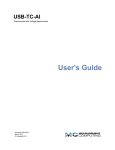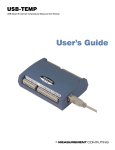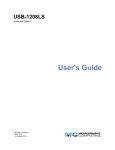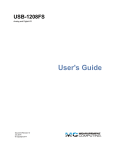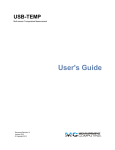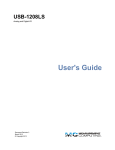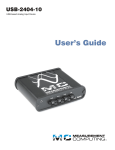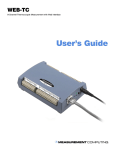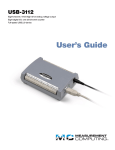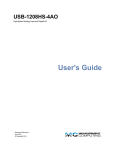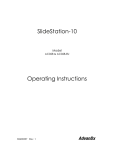Download USB-TC User's Guide - from Measurement Computing
Transcript
USB-TC Thermocouple Measurement User's Guide Document Revision 9 January 2014 © Copyright 2014 Your new Measurement Computing product comes with a fantastic extra — Management committed to your satisfaction! Thank you for choosing a Measurement Computing product—and congratulations! You own the finest, and you can now enjoy the protection of the most comprehensive warranties and unmatched phone tech support. It’s the embodiment of our mission: To provide data acquisition hardware and software that will save time and save money. Simple installations minimize the time between setting up your system and actually making measurements. We offer quick and simple access to outstanding live FREE technical support to help integrate MCC products into a DAQ system. Limited Lifetime Warranty: Most MCC products are covered by a limited lifetime warranty against defects in materials or workmanship for the life of the product, to the original purchaser, unless otherwise noted. Any products found to be defective in material or workmanship will be repaired, replaced with same or similar device, or refunded at MCC’s discretion. For specific information, please refer to the terms and conditions of sale. Harsh Environment Program: Any Measurement Computing product that is damaged due to misuse, or any reason, may be eligible for replacement with the same or similar device for 50% of the current list price. I/O boards face some harsh environments, some harsher than the boards are designed to withstand. Contact MCC to determine your product’s eligibility for this program. 30 Day Money-Back Guarantee: Any Measurement Computing Corporation product may be returned within 30 days of purchase for a full refund of the price paid for the product being returned. If you are not satisfied, or chose the wrong product by mistake, you do not have to keep it. These warranties are in lieu of all other warranties, expressed or implied, including any implied warranty of merchantability or fitness for a particular application. The remedies provided herein are the buyer’s sole and exclusive remedies. Neither Measurement Computing Corporation, nor its employees shall be liable for any direct or indirect, special, incidental or consequential damage arising from the use of its products, even if Measurement Computing Corporation has been notified in advance of the possibility of such damages. Trademark and Copyright Information Measurement Computing Corporation, InstaCal, Universal Library, and the Measurement Computing logo are either trademarks or registered trademarks of Measurement Computing Corporation. Refer to the Copyrights & Trademarks section on mccdaq.com/legal for more information about Measurement Computing trademarks. Other product and company names mentioned herein are trademarks or trade names of their respective companies. © 2014 Measurement Computing Corporation. All rights reserved. No part of this publication may be reproduced, stored in a retrieval system, or transmitted, in any form by any means, electronic, mechanical, by photocopying, recording, or otherwise without the prior written permission of Measurement Computing Corporation. Notice Measurement Computing Corporation does not authorize any Measurement Computing Corporation product for use in life support systems and/or devices without prior written consent from Measurement Computing Corporation. Life support devices/systems are devices or systems that, a) are intended for surgical implantation into the body, or b) support or sustain life and whose failure to perform can be reasonably expected to result in injury. Measurement Computing Corporation products are not designed with the components required, and are not subject to the testing required to ensure a level of reliability suitable for the treatment and diagnosis of people. HM USB-TC.docx 2 Table of Contents Preface About this User’s Guide ....................................................................................................................... 5 Conventions in this user's guide ......................................................................................................................... 5 Where to find more information ......................................................................................................................... 5 Chapter 1 Introducing the USB-TC ....................................................................................................................... 6 Overview: USB-TC features............................................................................................................................... 6 Functional block diagram ................................................................................................................................... 6 Connecting a USB-TC to your computer is easy ................................................................................................ 7 Chapter 2 Installing the USB-TC ........................................................................................................................... 8 What comes with your shipment? ....................................................................................................................... 8 Hardware .......................................................................................................................................................................... 8 Software ............................................................................................................................................................................ 8 Documentation .................................................................................................................................................................. 8 Unpacking........................................................................................................................................................... 8 Installing the software ........................................................................................................................................ 8 Installing the hardware ....................................................................................................................................... 8 Configuring the hardware ................................................................................................................................... 9 Calibrating the hardware..................................................................................................................................... 9 Chapter 3 Sensor Connections ...........................................................................................................................10 Screw terminal pinout ....................................................................................................................................... 10 Thermocouple input .........................................................................................................................................................10 CJC sensors......................................................................................................................................................................10 Digital I/O ........................................................................................................................................................................11 Power output ....................................................................................................................................................................11 Ground .............................................................................................................................................................................11 Thermocouple connections ............................................................................................................................... 11 Wiring configuration........................................................................................................................................................11 Digital I/O connections ..................................................................................................................................... 12 Chapter 4 Functional Details ...............................................................................................................................13 Thermocouple measurements ........................................................................................................................... 13 Cold junction compensation (CJC) ..................................................................................................................................13 Data linearization .............................................................................................................................................................13 Open-thermocouple detection (OTD) ..............................................................................................................................13 USB connector .................................................................................................................................................. 14 LED .................................................................................................................................................................. 14 Power ................................................................................................................................................................ 14 Chapter 5 Specifications ......................................................................................................................................15 Analog input ..................................................................................................................................................... 15 Channel configurations ..................................................................................................................................... 15 Accuracy ........................................................................................................................................................... 16 Thermocouple measurement accuracy .............................................................................................................................16 Throughput rate ................................................................................................................................................ 16 Digital input/output........................................................................................................................................... 17 3 USB-TC User's Guide Memory ............................................................................................................................................................ 17 Microcontroller ................................................................................................................................................. 17 USB +5V voltage ............................................................................................................................................. 17 Power ................................................................................................................................................................ 18 USB specifications ........................................................................................................................................... 18 Environmental .................................................................................................................................................. 18 Mechanical ....................................................................................................................................................... 18 Signal connector ............................................................................................................................................... 19 Declaration of Conformity ..................................................................................................................20 4 Preface About this User’s Guide This user's guide describes the Measurement Computing USB-TC data acquisition device and lists device specifications. Conventions in this user's guide For more information Text presented in a box signifies additional information related to the subject matter. Caution! Shaded caution statements present information to help you avoid injuring yourself and others, damaging your hardware, or losing your data. bold text Bold text is used for the names of objects on a screen, such as buttons, text boxes, and check boxes. italic text Italic text is used for the names of manuals and help topic titles, and to emphasize a word or phrase. Where to find more information Additional information about USB-TC hardware is available on our website at www.mccdaq.com. You can also contact Measurement Computing Corporation by phone, fax, or email with specific questions. Knowledgebase: kb.mccdaq.com Phone: 508-946-5100 and follow the instructions for reaching Tech Support Fax: 508-946-9500 to the attention of Tech Support Email: [email protected] 5 Chapter 1 Introducing the USB-TC Overview: USB-TC features The USB-TC is a USB 2.0 full-speed, thermocouple input module that is supported under popular Microsoft ® Windows® operating systems. The USB-TC is fully compatible with both USB 1.1 and USB 2.0 ports. The USB-TC provides eight differential thermocouple input channels. Eight independent, TTL-compatible digital I/O channels are provided to monitor TTL-level inputs, communicate with external devices, and to generate alarms. The digital I/O channels are software programmable for input or output. With the USB-TC, you can take measurements from type J, K, R, S, T, N, E, and B thermocouples. The USB-TC provides two integrated cold junction compensation (CJC) sensors for thermocouple measurements. An open thermocouple detection feature lets you detect a broken thermocouple. An on-board microprocessor automatically linearizes the measurement data. The USB-TC is a standalone plug-and-play module which draws power from the USB cable. No external power supply is required. All configurable options are software programmable. The USB-TC is fully software calibrated. Functional block diagram USB-TC functions are illustrated in the block diagram shown here. Figure 1. Functional block diagram 6 USB-TC User's Guide Introducing the USB-TC Connecting a USB-TC to your computer is easy Installing a data acquisition device has never been easier. The USB-TC relies upon the Microsoft Human Interface Device (HID) class drivers. The HID class drivers ship with every copy of Windows that is designed to work with USB ports. We use the Microsoft HID because it is a standard, and its performance delivers full control and maximizes data transfer rates for your USB-TC. No third-party device driver is required. The USB-TC is plug-and-play. There are no jumpers to position, DIP switches to set, or interrupts to configure. You can connect the USB-TC before or after you install the software, and without powering down your computer first. When you connect an HID to your system, your computer automatically detects it and configures the necessary software. You can connect and power multiple HID peripherals to your system using a USB hub. You can connect your system to various devices using a standard four-wire cable. The USB connector replaces the serial and parallel port connectors with one standardized plug and port combination. You do not need a separate power supply module. The USB automatically delivers the electrical power required by each peripheral connected to your system. Data can flow two ways between a computer and peripheral over USB connections. 7 Chapter 2 Installing the USB-TC What comes with your shipment? The following items are shipped with the USB-TC: Hardware USB-TC USB cable Software MCC DAQ CD Documentation In addition to this hardware user's guide, you should also receive the Quick Start Guide. This booklet provides an overview of the MCC DAQ software you received with the device, and includes information about installing the software. Please read this booklet completely before installing any software or hardware. Unpacking As with any electronic device, you should take care while handling to avoid damage from static electricity. Before removing the USB-TC from its packaging, ground yourself using a wrist strap or by simply touching the computer chassis or other grounded object to eliminate any stored static charge. If any components are missing or damaged, contact us immediately using one of the following methods: Knowledgebase: kb.mccdaq.com Phone: 508-946-5100 and follow the instructions for reaching Tech Support Fax: 508-946-9500 to the attention of Tech Support Email: [email protected] For international customers, contact your local distributor. Refer to the International Distributors section on our website at www.mccdaq.com/International. Installing the software Refer to the Quick Start Guide for instructions on installing the software on the MCC DAQ CD. This booklet is available in PDF at www.mccdaq.com/PDFmanuals/DAQ-Software-Quick-Start.pdf. Installing the hardware To connect the USB-TC to your system, turn your computer on, and connect the USB cable to a USB port on your computer or to an external USB hub that is connected to your computer. The USB cable provides power and communication to the USB-TC. When you connect the USB-TC to a computer for the first time, a Found New Hardware dialog opens when the operating system detects the device. When the dialog closes, the installation is complete. The USB LED should blink and then remain on. This indicates that communication is established between the USB-TC and your computer. Caution! Do not disconnect any device from the USB bus while the computer is communicating with the USB-TC, or you may lose data and/or your ability to communicate with the USB-TC. 8 USB-TC User's Guide Installing the USB-TC If the LED turns off If the LED is on but then turns off, the computer has lost communication with the USB-TC. To restore communication, disconnect the USB cable from the computer, and then reconnect it. This should restore communication, and the LED should turn back on. Configuring the hardware All hardware configuration options on the USB-TC are programmable with software. Use InstaCal to set the thermocouple type for each channel pair. Configuration options are stored on the USB-TC 's isolated microcontroller in EEPROM, which is non-volatile memory on the USB-TC module. Configuration options are loaded on power up. The factory default configuration is Type J thermocouple. Warm up Allow the USB-TC to warm up for 30 minutes before taking measurements. This warm up time minimizes thermal drift and achieves the specified rated accuracy of measurements. Calibrating the hardware The USB-TC is fully calibrated via InstaCal. Allow a 30 minute warm up before calibrating. 9 Chapter 3 Sensor Connections The USB-TC supports type J, K, R, S, T, N, E, and B thermocouples. Thermocouple selection The thermocouple type you select will depend on your application needs. Review the temperature ranges and accuracies of each type to determine which is best suited for your application. Screw terminal pinout The USB-TC has four rows of screw terminals — two rows on the top edge of the housing, and two rows on the bottom edge. Each row has 26 connections. Between each bank of screw terminals are two integrated CJC sensors used for thermocouple measurements. Signals are identified in Figure 2. Figure 2. Screw terminal pinout Use 16 AWG to 30 AWG wire for your signal connections. Tighten screw terminal connections When making connections to the screw terminals, be sure to tighten the screw until tight. Simply touching the top of the screw terminal is not sufficient to make a proper connection. Thermocouple input You can connect up to eight thermocouples to the differential sensor inputs ( C0H/C0L to C7H/C7L). The device supports type J, K, R, S, T, N, E, and B thermocouples. CJC sensors The USB-TC has two built in high-resolution temperature sensors. One sensor is located on the right side of the package, and one sensor is located at the left side. 10 USB-TC User's Guide Sensor Connections Digital I/O You can connect up to eight digital I/O lines to the screw terminals labeled DIO0 to DIO7. Each terminal is software configurable for input or output. Power output The two +5V terminals are isolated (500 VDC) from the USB +5V. Caution! Each +5V terminal is an output. Do not connect to an external power supply or you may damage the USB-TC and possibly the computer. Ground The six analog ground terminals (GND) provide a common ground for the input channels and DIO bits and are isolated (500 VDC) from the USB GND. Thermocouple connections A thermocouple consists of two dissimilar metals that are joined together at one end. When the junction of the metals is heated or cooled, a voltage is produced that correlates to temperature. The USB-TC makes fully differential thermocouple measurements without the need of ground-referencing resistors. A 32-bit floating point value in either a voltage or temperature format is returned by software. An open thermocouple detection feature is available for each analog input which automatically detects an open or broken thermocouple. Use InstaCal to select the thermocouple type (J, K, R, S, T, N, E, and B) and one or more sensor input channels to connect the thermocouple. Wiring configuration Connect the thermocouple to the USB-TC using a differential configuration, as shown in Figure 3. Figure 3. Typical thermocouple connection Connect thermocouples to the USB-TC such that they are floating with respect to GND (pins 9, 19, 28, 38). The USB-TC GND pins are isolated from earth ground, so connecting thermocouple sensors to voltages referenced to earth ground is permissible as long as the isolation between the GND pins (9, 19, 28, 38) and earth ground is maintained. When thermocouples are attached to conductive surfaces, the voltage differential between multiple thermocouples must remain within ±1.4 V. For best results, we recommend the use of insulated or ungrounded thermocouples when possible. Maximum input voltage between analog input and ground The absolute maximum input voltage between an analog input and the isolated GND pins is ±25 VDC when the device is powered on, and ±40 VDC when the device is powered off. If you need to increase the length of your thermocouple, use the same type of thermocouple wires to minimize the error introduced by thermal EMFs. 11 USB-TC User's Guide Sensor Connections Digital I/O connections You can connect up to eight digital I/O lines to the screw terminals labeled DIO0 to DIO7. You can configure each digital bit for either input or output. All digital I/O lines are pulled up to +5V with a 47 kΩ resistor (default). You can request the factory to configure the resistor for pull-down to ground if desired. When you configure the digital bits for input, you can use the USB-TC digital I/O terminals to detect the state of any TTL-level input. Refer to the schematic shown in Figure 4. If you set the switch to the +5V input, DIO0 reads TRUE (1). If you move the switch to GND, DIO0 reads FALSE (0). Figure 4. Schematic showing switch detection by digital channel DIO0 All ground pins are isolated from earth ground. If a connection is made to earth ground when using digital I/O and conductive thermocouples, the thermocouples are no longer isolated. In this case, thermocouples must not be connected to any conductive surfaces that may be referenced to earth ground For general information regarding digital signal connections and digital I/O techniques, refer to the Guide to DAQ Signal Connections (available on our web site at www.mccdaq.com/signals/signals.pdf). 12 Chapter 4 Functional Details Thermocouple measurements A thermocouple consists of two dissimilar metals that are joined together at one end. When the junction of the metals is heated or cooled, a voltage is produced that correlates to temperature. The USB-TC hardware level-shifts the thermocouple’s output voltage into the A/D’s common mode input range by applying +2.5 V to the thermocouple’s low side at the C#L input. Always connect thermocouple sensors to the USB-TC in a floating fashion. Do not attempt to connect the thermocouple low side C#L to GND or to a ground referencing resistor. Cold junction compensation (CJC) When you connect the thermocouple sensor leads to the sensor input channel, the dissimilar metals at the USBTC terminal blocks produce an additional thermocouple junction. This junction creates a small voltage error term which must be removed from the overall sensor measurement using a cold junction compensation technique. The measured voltage includes both the thermocouple voltage and the cold junction voltage. To compensate for the additional cold junction voltage, the USB-TC subtracts the cold junction voltage from the thermocouple voltage. The USB-TC has two high-resolution temperature sensors that are integrated into the design of the USB-TC. One sensor is located on the right side of the package, and one sensor is located at the left side. The CJC sensors measure the average temperature at the terminal blocks so that the cold junction voltage can be calculated. A software algorithm automatically corrects for the additional thermocouples created at the terminal blocks by subtracting the calculated cold junction voltage from the analog input's thermocouple voltage measurement. Increasing the thermocouple length If you need to increase the length of your thermocouple, use the same type of thermocouple wires to minimize the error introduced by thermal EMFs. Data linearization After the CJC correction is performed on the measurement data, an on-board microcontroller automatically linearizes the thermocouple measurement data using National Institute of Standards and Technology (NIST) linearization coefficients for the selected thermocouple type. The measurement data is then output as a 32-bit floating point value in the configured format (voltage or temperature). Open-thermocouple detection (OTD) The USB-TC is equipped with an open-thermocouple detection for each analog input channel. With OTD, any open-circuit or short-circuit condition at the thermocouple sensor is detected by the software. An open channel is detected by driving the input voltage to a negative value outside the range of any thermocouple output. The software recognizes this as an invalid reading and flags the appropriate channel. The software continues to sample all channels when OTD is detected. Input leakage current With open-thermocouple detection enabled, 105 nA (max.) of input leakage current is injected into the thermocouple. This current can cause an error voltage to develop across the lead resistance of the thermocouple that is indistinguishable from the thermocouple voltage you are measuring. You can estimate this error voltage with the following formula: error voltage = resistance of the thermocouple × 105 nA To reduce the error, reduce the length of the thermocouple to lower its resistance, or lower the AWG of the wire by using a wire with a larger diameter. With open-thermocouple detection disabled, 30 nA (max.) of input leakage current is injected into the thermocouple. 13 USB-TC User's Guide Functional Details USB connector The USB connector provides +5V power and communication. No external power supply is required. LED The LED indicates the communication status of the USB-TC. It uses up to 5 mA of current. The table below defines the function of the USB-TC LED. Illumination LED Illumination Indication Steady green Blinking green The USB-TC is connected to a computer or external USB hub. Data is being transferred. Upon connection, the LED blinks three times and then remains on; this indicates a successful installation. Power The two +5V terminals are isolated (500 VDC) from the USB +5V. Caution! Each +5V terminal is an output. Do not connect to an external power supply or you may damage the USB-TC and possibly the computer. 14 Chapter 5 Specifications All specifications are subject to change without notice. Typical for 25 °C unless otherwise specified. Specifications in italic text are guaranteed by design. Analog input Table 1. Generic analog input specifications Parameter Condition Specification Thermocouple Four dual 24-bit, Sigma-Delta type 8 differential 500 VDC minimum between field wiring and USB interface Thermocouple sensor type ±0.080 V A/D converters Number of channels Input isolation Channel configuration Differential input voltage range Absolute maximum input voltage Input impedance Input leakage current ±C0x through ±C7x relative to GND (pins 9, 19, 28, 38) Open thermocouple detect enabled Normal mode rejection ratio Common mode rejection ratio Resolution No missing codes Input coupling Warm-up time Open thermocouple detect fIN = 60 Hz fIN = 50 Hz/60 Hz CJC sensor accuracy 15 °C to 35 °C ±24 V power on, ±24 V power off 5 GΩ, min 105 nA max 90 dB min 100 dB min 24 bits 24 bits DC 30 minutes min Automatically enabled when the channel pair is configured for thermocouple sensors. The maximum open detection time is 3 seconds. ±0.25 °C typ, ±0.5 °C max –1.0 to +0.5 °C max 0 °C to 70 °C Channel configurations Table 2. Channel configuration specifications Sensor Category Condition Specification Thermocouple J, K, S, R, B, E, T, or N 8 differential channels Note 1: Note 2: Channel configuration information is stored in the EEPROM of the isolated microcontroller by the firmware whenever any item is modified. Modification is performed by commands issued over USB from an external application, and the configuration is made non-volatile through the use of the EEPROM. The factory default configuration is Type J. 15 USB-TC User's Guide Specifications Accuracy Thermocouple measurement accuracy Table 3. Thermocouple accuracy specifications, including CJC measurement error Sensor Type Maximum error (°C) Typical error (°C) Temperature range (°C) J ±1.499 ±0.643 ±1.761 ±0.691 ±2.491 ±1.841 ±2.653 ±1.070 ±1.779 ±0.912 ±1.471 ±0.639 ±1.717 ±0.713 ±1.969 ±0.769 ±0.507 ±0.312 ±0.538 ±0.345 ±0.648 ±0.399 ±0.650 ±0.358 ±0.581 ±0.369 ±0.462 ±0.245 ±0.514 ±0.256 ±0.502 ±0.272 –210 to 0 0 to 1200 –210 to 0 0 to 1372 –50 to 250 250 to 1768.1 –50 to 250 250 to 1768.1 250 to 700 700 to 1820 –200 to 0 0 to 1000 –200 to 0 0 to 600 –200 to 0 0 to 1300 K S R B E T N Note 3: Note 4: Note 5: Thermocouple specifications include linearization, cold-junction compensation and system noise. These specs are for one year, or 3000 operating hours, whichever comes first and for operation of the device between 15 °C and 35 °C. For measurements outside this range, add ±0.5 degree to the maximum error shown. There are CJC sensors on each side of the module. The accuracy listed above assumes the screw terminals are at the same temperature as the CJC sensor. Errors shown do not include inherent thermocouple error. Please contact your thermocouple supplier for details on the actual thermocouple error. Thermocouples must be connected to the device such that they are floating with respect to GND. The GND pins are isolated from earth ground, so connecting thermocouple sensors to voltages referenced to earth ground is permissible as long as the isolation between the GND pins and earth ground is maintained. When thermocouples are attached to conductive surfaces, the voltage differential between multiple thermocouples must remain within ±1.4V. For best results we recommend the use of ungrounded or insulated thermocouples when possible. Throughput rate Table 4. Throughput rate specifications Number of input channels Maximum throughput 1 2 3 4 5 6 7 8 2 S/s 2 S/s on each channel, 4 S/s total 2 S/s on each channel, 6 S/s total 2 S/s on each channel, 8 S/s total 2 S/s on each channel, 10 S/s total 2 S/s on each channel, 12 S/s total 2 S/s on each channel, 14 S/s total 2 S/s on each channel, 16 S/s total 16 USB-TC User's Guide Note 6: Specifications The analog inputs are configured to run continuously. Each channel is sampled twice per second. The maximum latency between when a sample is acquired and the temperature data is provided by the USB unit is approximately 0.5 seconds. Digital input/output Table 5. Digital input/output specifications Parameter Specification Digital type Number of I/O Configuration CMOS 8 (DIO0 through DIO7) Independently configured for input or output. Power on reset is input mode. All pins pulled up to +5 V via 47 K resistors (default). Pull-down to ground (GND) also available. Digital input: 50 port reads or single bit reads per second, typ Digital output: 100 port writes or single bit writes per second, typ 2.0 V min, 5.5 V absolute max 0.8 V max, –0.5 V absolute min 0.7 V max Pull-up/pull-down configuration Digital I/O transfer rate (software paced) Input high voltage Input low voltage Output low voltage (IOL = 2.5 mA) Output high voltage (IOH = –2.5 mA) Note 7: 3.8 V min All ground pins are isolated from earth ground. If a connection is made to earth ground when using digital I/O and conductive thermocouples, the thermocouples are no longer isolated. In this case, thermocouples must not be connected to any conductive surfaces that may be referenced to earth ground. Memory Table 6. Memory specifications Parameter Specification EEPROM 1,024 bytes isolated micro reserved for sensor configuration 256 bytes USB micro for external application use Microcontroller Table 7. Microcontroller specifications Parameter Specification Type Two high performance 8-bit RISC microcontrollers USB +5V voltage Table 8. USB +5V voltage specifications Parameter Specification USB +5V (VBUS) input voltage range 4.75 V min to 5.25 V max 17 USB-TC User's Guide Specifications Power Table 9. Power specifications Parameter Condition Specification Supply current Supply current (Note 8) User +5V output voltage range (pins 21 and 47) User +5V output current (pins 21 and 47) Isolation USB enumeration Continuous mode <100 mA 140 mA typ Connected to self-powered hub. (Note 9) Bus-powered and connected to a self-powered hub. (Note 9) 4.75 V min to 5.25 V max 10 mA max Measurement system to PC 500 VDC min Note 8: Note 9: This is the total current requirement for the device which includes up to 10 mA for the status LED. Self-Powered Hub refers to a USB hub with an external power supply. Self-powered hubs allow a connected USB device to draw up to 500 mA. Root Port Hubs reside in the PC USB Host Controller. The USB port(s) on your PC are root port hubs. All externally powered root port hubs (desktop PC’s) provide up to 500 mA of current for a USB device. Battery-powered root port hubs provide 100 mA or 500 mA, depending upon the manufacturer. A laptop PC that is not connected to an external power adapter is an example of a battery-powered root port hub. USB specifications Table 10. USB specifications Parameter Specification USB device type Device compatibility Device power capability USB cable type USB 2.0 (full-speed) USB 1.1, USB 2.0 Self-powered, 100 mA consumption max A-B cable, UL type AWM 2725 or equivalent. (min 24 AWG VBUS/GND, min 28 AWG D+/D–) 3 m (9.84 ft) max USB cable length Environmental Table 11. Environmental specifications Parameter Specification Operating temperature range Storage temperature range Humidity 0 °C to 70 °C –40 °C to 85 °C 0% to 90% non-condensing Mechanical Table 12. Mechanical specifications Parameter Specification Dimensions (L × W × H) User connection length 128.52 x 88.39 × 35.56 mm (5.06 × 3.48 × 1.43 ft) 3 m (9.84 ft) max 18 USB-TC User's Guide Specifications Signal connector Table 13. Signal connector specifications Parameter Specification Connector type Wire gauge range Screw terminal 16 AWG to 30 AWG Table 14. Screw terminal pinout Pin 1 2 3 4 5 6 7 8 9 10 Signal Name RSVD NC C0H C0L NC RSVD C1H C1L GND RSVD Pin Description Reserved, Do Not Use No connection CH0 sensor input (+) CH0 sensor input (–) No connection Reserved, Do Not Use CH1 sensor input (+) CH1 sensor input (–) Ground Reserved, Do Not Use Pin 27 28 29 30 31 32 33 34 35 36 CJC sensor 11 12 13 14 15 16 17 18 19 20 21 22 23 24 25 26 RSVD NC C2H C2L NC RSVD C3H C3L GND RSVD +5V GND DIO0 DIO1 DIO2 DIO3 Signal Name RSVD GND C7L C7H RSVD NC C6L C6H NC RSVD Pin Description Reserved, Do Not Use Ground CH7 sensor input (–) CH7 sensor input (+) Reserved, Do Not Use No connection CH6 sensor input (–) CH6 sensor input (+) No connection Reserved, Do Not Use CJC sensor Reserved, Do Not Use No connection CH2 sensor input (+) CH2 sensor input (–) No connection Reserved, Do Not Use CH3 sensor input (+) CH3 sensor input (–) Ground Reserved, Do Not Use +5V output Ground DIO channel 0 DIO channel 1 DIO channel 2 DIO channel 3 37 38 39 40 41 42 43 44 45 46 47 48 49 50 51 52 19 RSVD GND C5L C5H RSVD NC C4L C4H NC RSVD +5V GND DIO7 DIO6 DIO5 DIO4 Reserved, Do Not Use Ground CH5 sensor input (–) CH5 sensor input (+) Reserved, Do Not Use No connection CH4 sensor input (–) CH4 sensor input (+) No connection Reserved, Do Not Use +5V output Ground DIO channel 7 DIO channel 6 DIO channel 5 DIO channel 4 Declaration of Conformity Manufacturer: Address: Category: Measurement Computing Corporation 10 Commerce Way Suite 1008 Norton, MA 02766 USA Electrical equipment for measurement, control and laboratory use. Measurement Computing Corporation declares under sole responsibility that the product USB-TC to which this declaration relates is in conformity with the relevant provisions of the following standards or other documents: EC EMC Directive 2004/108/EC: General Requirements, EN 61326-1:2006 (IEC 61326-1:2005). Emissions: EN 55011 (2007) / CISPR 11(2003): Radiated emissions: Group 1, Class A EN 55011 (2007) / CISPR 11(2003): Conducted emissions: Group 1, Class A Immunity: EN 61326-1:2006, Table 3. IEC 61000-4-2 (2001): Electrostatic Discharge immunity. IEC 61000-4-3 (2002): Radiated Electromagnetic Field immunity. To maintain compliance to the standards of this declaration, the following conditions must be met. The host computer, peripheral equipment, power sources, and expansion hardware must be CE compliant. All I/O cables must be shielded, with the shields connected to ground. I/O cables must be less than 3 meters (9.75 feet) in length. The host computer must be properly grounded. The host computer must be USB 2.0 compliant. Equipment must be operated in a controlled electromagnetic environment as defined by Standards EN 61326-1:2006, or IEC 61326-1:2005. Note: Data acquisition equipment may exhibit noise or increased offsets when exposed to high RF fields (>1V/m) or transients. Declaration of Conformity based on tests conducted by Chomerics Test Services, Woburn, MA 01801, USA in April, 2005. Test records are outlined in Chomerics Test Report #EMI4193.05. Further testing was conducted by Chomerics Test Services, Woburn, MA. 01801, USA in December, 2008. Test records are outlined in Chomerics Test Report #EMI5215B.08. We hereby declare that the equipment specified conforms to the above Directives and Standards. Carl Haapaoja, Director of Quality Assurance Measurement Computing Corporation 10 Commerce Way Suite 1008 Norton, Massachusetts 02766 (508) 946-5100 Fax: (508) 946-9500 E-mail: [email protected] www.mccdaq.com





















